CREtech Consulting Report: Reimagining Cities and the Entire Built World
CREtech Blog
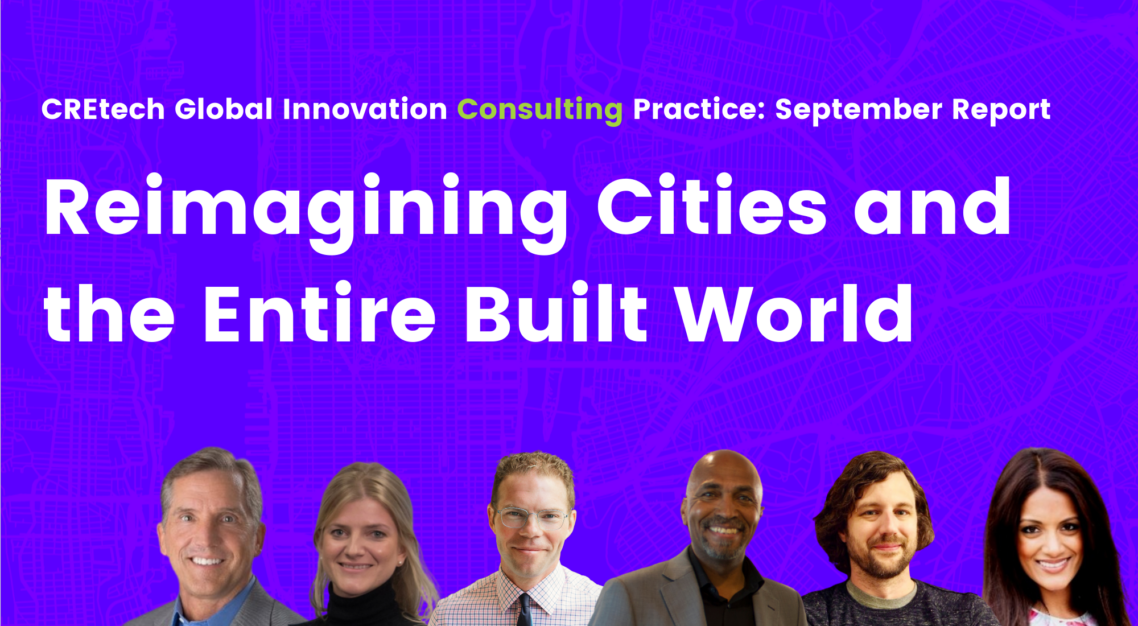
CREtech is proud to introduce our new monthly content series focused on our Global Innovation Consulting Practice. Each month we will take a deep dive on an important trend in the world of real estate technology and innovation. These themes, which are carefully selected by our world-class team of Consultants and Advisors, will then be released to our community through a series of insightful webinars, blogs and market research.
CREtech Consulting Talks: Reimagining Cities and the Entire Built World
COVID-19 has caused corporations, tenants, residents, and developers to rethink their entire approach to workspaces and placemaking. The pandemic’s massive disruption in the Built World will have a far reaching and lasting impact on how spaces are designed, built, and occupied, as well as how cities are transformed as a result. Health and wellness is now center stage, a change generating more questions than answers right now.
What will become of the traditional office? Will the work-from-home (WFM) phenomenon greatly accelerate the flex-space sector? What will become of obsolete malls and hotels? Will the logistics sector encroach the suburban and urban sectors? Will modular construction help meet the demand for affordable housing? What does the new “work from anywhere” real estate portfolio look like from an employer/occupier perspective? Instead of having a large, internalized footprint, it’s going to become a mix of dedicated offices, third-party workspace, and WFH subsidies. But what should that mix be and who’s doing it right?
"My ideas for transforming spaces, developments, and cities over the next five years center around the ideas of empathy,” says Devin Vermeulen, Consultant for CREtech Global Innovation Consulting Practice. “I'd love to live in a world where development programming and strategy is driven by community, culture, and user needs; and that financial success is a result of and tied to those outcomes. Authentic dedication to the needs and happiness of a community can help create long lasting, sustainable environments that allow all of us to share in the upside of progress."
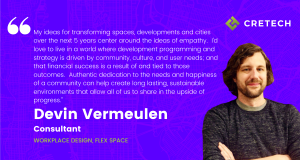
Now that consumers have more choice than ever, “real estate’s value proposition must focus more on the quality of services provided through real estate rather than just the bricks and mortar,“ according to Digital Disruption’s The Future of Cities Post Covid report.
With the help of leading experts from the worlds of smart cities and buildings, architecture, design, and construction, CREtech takes the long view on how the entire physical world of commercial real estate will be transformed in both the short and long term. What’s around the bend that you should be planning for now? Afterall, those who succeed in the years beyond the immediate crisis “will have taken bold actions that deepen relationships with their employees, investors, end users, and other stakeholders,” according to McKinsey & Company.
Health Takes Center Stage
Facing the first worldwide pandemic in 100 years, it’s no surprise that health and wellness is on everyone’s minds. And while COVID-19 is sweeping through now, it won’t be the last health crisis the economy has to overcome. Even if it’s not mandated, you can bet the number of germaphobes to appease in the years and decades to come is up and to the right. Yet the industry is not doing enough, according to our polling.
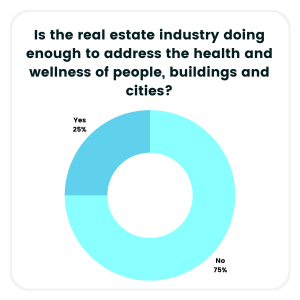
“The current environment and impact of COVID means individuals are taking a closer look at immunity and well-being with an intensified interest in strengthening health,” according to Khushbu Sikaria, Principal, KSA & Advisor at CREtech Global Innovation Consulting Practice. “The right design can not only help weave together diverse aspects of care in a way that feels easy and seamless, but also inspires a sense of well-being and security that will be essential to bring back to a post-COVID world.”
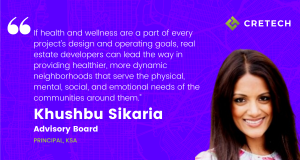
Health and wellness is already being woven into the fabric of public life. According to JLL trends research in China, “80 percent of Class A office buildings are requiring employees to take their temperature at the entry turnstile. If their temperature is recorded over 100 degrees, visitors are not allowed into the property. This procedure has been expanded to large grocery stores and enclosed places.”
Given the anticipation that global health emergencies may become more commonplace in the future, McKinsey & Company reported that “Public-health officials may increasingly amend building codes to limit the risk of future pandemics, potentially affecting standards for HVAC, square footage per person, and amount of enclosed space.”
The short of it is this: Public health and safety measures integrated into real estate design and planning will increasingly become table stakes to operate in the world awaiting us in the future.
Commercial / Office Headwinds
Many organizations will increasingly turn to advanced office analytics to not only keep tabs on building status or employee health, but also how people are working, where, and with whom. Occupiers will need to bolster their capabilities for orchestrating massively distributed workforces. If face-to-face meetings become the focal point of the post-COVID office, they’ll need to make sure the right people—and only the right people—are in the room.
This means a fundamental rethinking of workplace layouts and employee densities to better “address some forms of always-on social distancing,” according to JLL trends research. Further, that research concludes that “tenants and building owners will also need to carefully rethink communal spaces, shared amenities, and potentially crowded ‘bottlenecks’ including lobbies, elevators, bathrooms, and cafés. Estimating usage, monitoring and managing density and flow, and creating flexibility to make adjustments and communicate protocols will be critical for reentry and the near-term transition period.” A few examples of tech companies rising to the challenge include:
- Hq0’s release of new Capacity Manager and Building Population Report which both provide important data on tenant and employee engagement and can also assist with contact-tracing needs among growing Covid-19 concerns.
- Density's Safe, a real-time occupancy system measures the use of buildings and preserves both employee and customer privacy.
- Envoy's Protect product controls workplace access to, prevent overcrowding.
- Proxyclick's Return Ready Playbook helps professionals get back to work quickly, safely, and without compromise. It's based on three pillars: Prepare, Prevent, Protect.
- Equiem's Return to Workplace solutions guide, a complete end-to-end solution on how to retain your tenants and return them safely to your building
- Rise Building's property experience platform providing better real-time communication and connectivity for buildings around the country.
Beyond office, retail is also in for a major upheaval. “A wave of defaults, bankruptcies and evictions expected in cities across the U.S. is poised to remake the retail landscape across the country,” according to JLL. But that doesn’t mean traditional retail is now obsolete—it’s down, but not out. Expect an increased emphasis on design for ground-up development, doubling down on omnichannel, in-store tech, retail to housing conversions, and more digital brands making the leap to physical storefronts.
Let’s more closely examine a few specific trends in the commercial and office sectors.
WFH Won’t Last Forever
Innovation is the lifeblood of great organizations. Organizations once quick to embrace WFH forever may have been too hasty—data is already emerging on how organizations are becoming more siloed, struggling to innovate, launch new initiatives, maintain culture, and onboard new employees. Many organizations will discover those 5% real estate savings aren’t worth the long term trade-offs. Count Netflix CEO Reed Hastings among those executives who believe working from home is detrimental to the company’s success; he’s planning to bring employees back to the office as soon as a vaccine is available.
Innovation is a squishy topic often without a clear ROI in the short term, but without it, tech will languish from their current market leader positions. According to JLL, the importance of “working together in a physical space is [clear] for the quality and innovation. But we have to rethink how we are going to keep our spaces and employees safe during re-entry.”
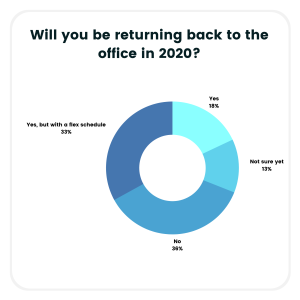
The other side of the coin is the employees. While some enjoy the newfound freedom to work in their pajamas for days on end, others—particularly those with kids—find the chaos at home hugely unsettling. A recent JLL employee survey showed “only 4.9% of office workers will be comfortable with exclusively working from home and would prefer to do so going forward,” and “60.6 percent [of workers] plan to return to the office for parts of their work week, while still working a considerable portion of their time at home.” Backyards are where we’ll see a flurry of commercial innovation as a surge in backyard office construction engulfs us: the AOU (accessory office unit) movement, according to Drew Meyers, founder of Geek Estate.
Pivoting a multinational product strategy to compete against startups without in-person dynamics is easy to say, but not execute. With speed to market now more essential than ever, safety-conscious but in-person teamwork will still be prioritized to solve big problems, meaning WFH as a first-line option for all employees will become a relic of the past.
Shared Workspaces Aren’t Dead
The shared workspace revolution has only just begun. Not only will we see more—and more varied—spaces, but the coworking renaissance will mean knowledge work spilling over into many other typologies: mall storefronts, big box stores, outdoor parklets, etc. Shuttered restaurants will transform into workspaces; offices may become residential, and so on. Huge shifts in the landscape mean consolidation is all but a sure thing.
According to a June 2020 CBRE Research Client Survey, “70% of respondents indicated that some portion of their workforce will be allowed to work remotely full-time [and] 61% of respondents indicated that all employees would be allowed to work outside the office at least part-time. [Additionally,] … 41% said the importance of the physical office will decrease only slightly and 38% said it will remain as important, if not more.”
Our polling shows two-thirds of people believe flex space will actually increase in the near term, a boon for a sector that has been ravaged in recent months.
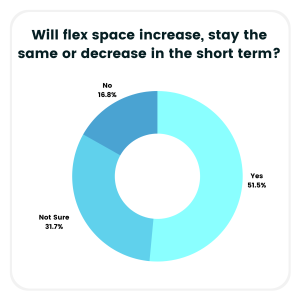
Demand for flexibility isn’t going to wane no matter the trajectory the pandemic takes. JLL’s The Impact of COVID-19 on Flexible Space report “predicts that 30 percent of all office space will be consumed flexibly by 2030.” Corporates and investors realize that “the demand drivers that led to the flexible space boom are still intact” and that “these trends will be compounded by organizations’ unwillingness to assume long-term lease liabilities and commit to large capex projects, therefore opting for pre-built spaces with lease flexibility.”
Industrial Strength Renaissance
With e-commerce booming beyond belief, industrial is reaping the benefits. “Self-storage facilities, industrial facilities, and data centers have faced less-significant declines” than real estate assets with greater human density according to McKinsey & Company. Self-storage and cloud kitchens are two assets that stand to see a boost in their unit economics. As consumer behavior permanently shifts in the wake of the pandemic, those new behaviors have created reciprocal avenues for growth in the industrial sector.
“The increase in online grocery orders is expected to continue, and growth in the U.S. cold storage space will be necessary to facilitate it,” notes Julia Silva, Managing Director, JLL, Capital Markets. “With both cold storage and fulfillment centers, the complexities of direct-to-consumer facilities require either new construction or renovations.”
And retail to industrial conversions are in process: Amazon is speaking with Simon Property Group, America's biggest mall owner, to transform empty retail space formerly occupied by Sears and JCPenney into Amazon fulfillment warehouses.
Net-net: More deliveries, time at home, and less venturing out into the physical world is a massive boon for industrial logistics—which requires physical space.
Cities
Pandemics are nothing new. “The global history of plague is a centuries-old tale of civic calamity, with urban centers the main vectors of contagion and suffering,” according to The Washington Post.
But alongside the downsides of such episodes come societal advances for metropolises. “Without a series of devastating global cholera outbreaks in the 19th century—including one in London in the early 1850s that claimed more than 10,000 lives—the need for a new, modern sewerage system may never have been identified,” reports The Guardian. Meanwhile, the Athens plague (430 BC) “drove profound changes in the city’s laws and identity” and the Black Death (Middle Ages) “transformed the balance of class power in European societies.” More recently, the “Ebola epidemics across sub-Saharan Africa ...illuminated the growing interconnectedness of today’s hyper-globalised cities.”
These are a few urban trends we’re following closely.
Proximity Becomes Everything
The importance of physical proximity has changed, which of course impacts big cities far and wide. “If proximity to one’s job is no longer a significant factor in deciding where to live, for example, then the appeal of the suburbs wanes; we could be heading towards a world in which existing city centres and far-flung “new villages” rise in prominence, while traditional commuter belts fade away,” according to The Guardian.
The middle ground is proximity cities, a blend of suburbs and urban. Greg Lindsay, Consultant at CREtech Global Innovation Consulting Practice, is “closely following the rise of what [he calls the] ‘Proximity City’—our new hyper-local existence within 15 minutes of home.” He continues, “It’s a city most easily navigated on foot or by bicycle, one in which real estate has to do double- or triple-duty as live/work/play and formerly dormant places like parking and street space are repurposed as productive assets. Paris, Milan, and Montréal are leading the way, but there’s a real opportunity to find the long-elusive happy medium between American cities and suburbs along this model.”

Tech-Driven Dynamics
Across the board, people are predicting that “public spaces will move toward more automation to mitigate contagion, according to Architectural Digest. The rapid increase in touchless technology will include “automatic doors, voice-activated elevators, cellphone-controlled hotel room entry, hands-free light switches and temperature controls, automated luggage bag tags, and advanced airport check-in and security.”

“People will experience cities in an entirely different way in the next five years,” predicts Patrick Klein, CTO, Essex Property Trust & Advisor, CREtech Global Innovation Consulting Practice “We will go from interacting with services on demand and move to more responsive technologies that anticipate needs and actions as you move around. For example, why approach a crosswalk signal and press a button when AI can anticipate actions and call for the signal to change and in turn keep foot traffic moving ahead of reaching a crossing? It will not be the autonomous vehicles that are the change but the smart systems opening doors and changing advertising signage as app usage for a particular destination increases or decreases. Movement will be dynamic.”
The Architectural Role
Socially distant life is here, but is it here to stay? We all hope it’s a temporary state of society, but it’s not unreasonable to believe “concerns about future viruses might encourage architects to design with an eye toward open spaces that enable and encourage people to spread out,” according to Architectural Digest. While it’s not likely we’ll see the death of sports and entertainment facilities, changes are afoot to enable thousands to feel safe with time in close quarters. For instance, Architect Dan Meis “expects arenas to introduce far more opportunities for hand washing and sanitizing as well as RIFD [sic] technology to make purchases."
Others interviewed in the Architectural Digest story note similar health and wellness considerations will make it into future projects. “Designers will increasingly call on antibacterial fabrics and finishes” that were once overlooked because of cost concerns, according to Craig Scully, partner and chief engineer at Design Collaborative. And Miami architect Kobi Karp predicts a rise in “self-cleaning bathrooms as well as pod rooms—smaller modular spaces that can be sealed off from other guests while also offering the ability to be quickly torn down and disinfected.” The key is to keep spaces habitable, however. Rami el Samahy from architecture and design firm OverUnder cautions: “Giving up on urbanity and density is the wrong solution—after all, we still have a planet to save.”
COVID-19 is giving “our planet a remedial lesson about how we are all connected, and architecture may be the science that consolidates this terrible but liberating new wisdom,” says Philip Kennicott at the Washington Post. At the end of the day, “We need architecture that is sustainable, flexible, adaptive, responsive and local, but without being parochial.”
A Spectacle to Come
CEO’s responding to KPMG’s 2020 CEO Outlook: Covid-19 Special Edition “recognize that recovery from the pandemic does not mean a return to ‘normal’. Instead, there is an opportunity to define a new future.” Our new future is coming on a number of fronts.
“The real estate trends of how people want to live, work, and shop were already in motion—albeit largely still in their infancy,” according to Michael Beckerman, CEO of CREtech.com, “but the pandemic accelerated technology adoption 10X in many cases.” KPMG’s 2020 CEO Outlook also highlighted how digital acceleration is shaping the future of industries—“organizations will need a deep understanding of how customer behavior will shift and how to meet these emerging demands.”
Health and wellness is one long term sea change that owners and operators cannot sidestep. Sikaria sums it up well: “If health and wellness are a part of every project’s design and operating goals, real estate developers can lead the way in providing healthier, more dynamic neighborhoods that serve the physical, mental, social, and emotional needs of the communities around them.”
And while offices must evolve to meet the moment, “they will remain the beating hearts of the central business districts in major cities across the globe, supporting a lively hinterland of retail, leisure and cultural attractions. This, in turn, will sustain the attractiveness of urban living,” according to Christian Ulbrich, the CEO of JLL. KPMG’s 2020 CEO Outlook backs up that assumption, with 69 percent of the 315 CEOs indicating they will be downsizing office space. With that sentiment, there is no question the office sector is going to go through a transformation like the world has never seen before.
The pandemic also surfaced undercurrents of dysfunction on multiple fronts, according to Beckerman. “Cities were grappling with congestion, pollution, overpricing, and a resulting challenge attracting talent. Young professionals were increasingly disillusioned with the nature and purpose of work and increasingly concerned with quality of life. These macro headwinds, coupled with the dominance of technology in every corner of society, created the perfect storm for the pandemic to rapidly accelerate many trends that were destined to manifest.”
The greatest age of innovation in the Built World in our lifetimes is about to unfold. The very fabric holding together our cities is being rewritten right before our eyes. Get out your lawn chair and grab a bag of popcorn. You won’t be disappointed.
Watch Now - CREtech Consulting Talks Webinar: Reimagining Cities and the Entire Built World
[embed]https://www.youtube.com/watch?v=Mb-ZCcB4EMg[/embed]
WE HAVE CURATED THE MOST EXPERIENCED TEAM OF REAL ESTATE TECH CONSULTANTS IN THE WORLD TO HELP YOU FUTURE PROOF YOUR BUSINESS.
We understand your company’s unique tech objectives, analyze current practices, and recommend new solutions that will accelerate your tech adoption and overall operational efficiency. We also offer onboarding solutions to ensure a smooth transition, train your employees and make the process as simple as possible for you.
contact us at consulting@cretech.com to learn more or visit www.cretech.com/consulting
